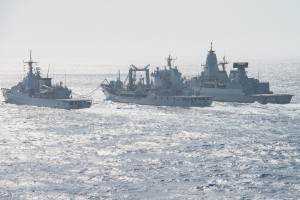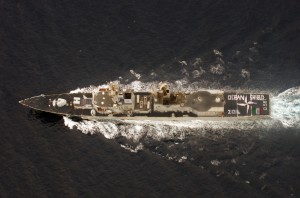2015-06-12 by Murielle Delaporte
Interview with Rear Admiral Juan A. Cornago, Spanish Navy, MARCOM DCOS Support
Rear Admiral Juan Cornago joined the Spanish Navy College in 1979 and served in the amphibious ship Aragon and in the Navy Air Wing as a Harrier pilot.
He then commanded several ships, including the amphibious ship Galicia in 2010 during the Atalanta operation.
He is now Deputy Chief of Staff Support at Northwood headquarters where he had already served as N7 training branch head between 2002 and 2005.
Rear Admiral Cornago arrived at MARCOM (Allied Maritime Command) in his current position, as the NATO Command Structure Reform launched at the Lisbon Summit in 2010 was being implemented with the merger of Maritime Command Naples and Maritime Command Northwood, with the latter becoming the headquarters for all NATO Standing Maritime Groups, i.e. two Standing NATO Maritime Groups (SNMG 1 and 2) and two Standing NATO Mine Countermeasures Groups (SNMCMG 1 and 2).
In the interview below, he describes his mission as head of logistics for MARCOM, the specificities of maritime logistics in general and within NATO.
He is tasked as well with navigating the way ahead towards a better coordination and integration of NATO members’ naval assets within the Alliance overall strategy and the Readiness Action Plan set during the last Summit in Wales in 2014.
Ensuring life support
As DCOS Support, my responsibility is to deliver life support for the operational forces.
Logistics is about planning and providing the right sustainment and replenishment to the naval forces in order to maintain capabilities in the theaters, whether it involves personnel, fuel, ammunition and so on.
My role at the strategic level is to provide the advice and expertise when it is required, in particular through various working groups.
At the operational level, my main role here in Northwood is to participate in the planning of exercises and operations.
And at the tactical level, we are, as a maritime training command, also responsible for the assigned forces on a permanent basis.
We therefore have different levels of responsibilities, which is not a small task and we have to be careful to keep the right balance between the operational and the tactical levels.
My directorate runs the logistics, but we had to change our mindset as MARCOM used to be a tactical command: we shall reached our operational capability this summer, although we do not forget that we still have a tactical role in support of the Standing Naval Forces under our command.
Deployable by nature
In the maritime domain, ships can store, so sailors tend to encounter less issues than troops on land.
We have no problem to maintain sustainment to the forces at sea, as long – however – as the sea lines of communication (SLOC) are maintained open.
If the deployability of NATO forces as a whole involves many logistics aspects, in the naval field, we are deployable per se.
The way we do logistics is to send out as much supply as possible to a place within the theater where the threat is not as important: we forward deploy a logistics base from which we go back and forth to resupply the forces.
We use ships and tankers, which are always in the theater, to transfer storages to other naval forces.
So we are not so much worried about prepositioning.
Navies reason more in terms of pre-deployment than prepositioning, while some nations like the United States are in the process of developing floating sea bases.
Fostering a collective approach to maritime logistics among NATO allies
In NATO, the nations have the responsibility to support the forces they provide and our effort is to coordinate those efforts.
During the planning of operations, we put in place the right structure to be able to do so in coordination with a representative of each nation.
We interact with other NATO agencies in order to get the right expertise as far as host nation support or contracting are concerned.
Navies have been used to work together for a long time, especially since the NATO Standing Maritime Groups have been in place for decades.

This common history has led us to a standardization process, regarding not only in procedures, but also in the adoption of standards in systems among different Navies.
We have therefore been able to reach a good interoperability level.
In refueling for instance, we all use the same fuel and equipment, so any ship can be refueled at sea.
Another example relates to the standing procedure set up among naval allied powers to share spare parts: when a ship has a specific need, the crew will, before asking its own national authorities, inquire within the Task Force via an EMREC (Emergency Requirement).
Thanks to NATO’s standardization number, it is often possible to find the missing spare part within NATO forces on short notice, which saves a lot of time and resources.
The same goes with the use of helicopters within a Standing Maritime Group (SNMCMGs do not have a dedicated helicopter): the Commander of the Group will look after making the best use of the pool available for the common good.
These are examples of what a future collective approach to logistics could further develop.
If we are a long way to some kind of burdensharing among nations as far as logistics capabilities are concerned, since nations are independent and have national interests outside the Alliance, the latter does create an environment favorable to foster pooling and sharing.
There exists as a matter of fact many bilateral agreements (e.g. common maintenance of the Seafox fleet between the Netherlands and Belgium; common brigade for amphibious operations between Spain and Italy; etc), which NATO is very happy with and encourages, but does not lead.
Recent operations have only reinforced the value of a collective approach to logistics, which the nations have increasingly gained appreciation of.
Ocean shield as NATO’s naval landmark
Because of this long history of NATO Navies working together for decades, manœuvering together requires more fine-tuning than resetting. However we always apply lessons learned in order to better prepare for the future.
In that sense, the same way Afghanistan has redefined in many regards air and land coalition warfare, Ocean Shield has been a challenge for NATO naval forces at the beginning of the operation, in particular in terms of refueling.
The Indian Ocean is a huge area with very little ports available, so we had to rely more on support at sea as well as host nation support.
Because some of the coalition forces already operate in that part of the world, we were able to fill the gaps. But it has definitely been a major mindset shift in the way NATO had been operating till then.
One of the issues we encountered during Ocean Shield concerns Medevacs, since we did not have a Role 2 at sea.
Usually we operate close to the shores of a member-nation of the Group, which provides a helicopter for a medical emergency.

So it is just a problem of coordination.
In this case, the distance had a true operational impact and we had to mitigate by embarking a forward surgical medical team onboard to ease problems.
Some of the ships are able to provide a Role 2, such as big amphibious ships, tankers, LPDs (landing platform/dock), but not all.
Frigates for instance cannot and that is why we now include a forward surgical team in the crew.
We are hence pursuing within NATO such a collective approach, so even though all nations do not have the same capabilities and do not necessarily have tankers or hospital ships or supply ships, they can still operate within a Naval Group.
When we prepare to go into an operation, we ask for the combined operational requirements which nations can fill.
The harmonization of already standardized NATO procedures provides the necessary commonality.
The Way Ahead: joint logistics C2 as the foundation
NATO’s logistics vision has set four lines of efforts:
- Enhancing deployability;
- Reinforcing sustainability;
- Building more capable and interoperable systems;
- Creating a solid logistics C2 capability.
These are the guidelines for the future. In the maritime domain, we do not have to work so much on deployability and sustainability, as these requirements are inherent to us and have been worked out.
Autonomy at sea ranges between one to two week for SNMCMGs to twenty to twenty-five days for SNMGs.

A frigate will hold that much supply on board, but through tankers and supply ships we can keep it going, again, as long as sea lines of communication are open.
There is of course however a human limit, since crews usually need to rest after six months of deployment.
What is new is the objective we have regarding logistics Command and Control.
As we interact more at the joint level and work closer together at the planning level to prepare the exercises, we have to coordinate and integrate the traditional modus operandi of maritime logistics with new ways of operating on the basis of a solid C2 in logistics on the theater, in the commanding structure as well as at the joint units’ level.
We indeed need to integrate the maritime domain with the Joint Logistics Support Group concept[ref] According to NATO’s 2009 document entitled “Allied Joint Doctrine For Logistics AJP – 4(B)”, « the creation of the NATO Response Force (NRF) led to the development of a conceptual framework for logistic support to NRF operations; “MC 526, Logistics Support Concept for NRF Operation”. Since NATO logistic support options (including their command and control (C2) relationship) were lacking in their ability to effectively support a NRF Operation, new logistic principles have been introduced in the NRF Logistic Support Concept » (source: http://hogskolene.forsvaret.no/english/Documents/AJP-4%28B%29%20Logistics%20doctrine%202009.pdf)[/ref]
We are doing a lot of work in that direction, especially as far as logistics Command and control are concerned.
The processes are there, as JLSG has been exercised before, but it is the first time MARCOM will join.
This does require more coordination and we have been planning two exercises, which will test this ability.
Trident Jewel 2015 is a small exercise, but it has been a challenge, as it is the first time we operate at a joint level from a logistics point of view. We are in the process of learning how to tackle the land and air logistics as well.
The second exercise is Trident Juncture 2015 to occur in the Fall.
We shall be in charge of the maritime planning of what will be the largest Livex [Live exercise] of NATO in fifteen years.
But no matter how much one plans, the level of required supply can vary: it is in that regard the same at land or at sea.
Editor’s Note: Murielle Delaporte went to sea with the NATO counter-mine task force and was onboard the German Marine Tender Donau earlier this year.
She is the co-founder of Second Line of Defense and the editor of Operationnels where a complete dossier on the NATO approach to mine warfare is discussed from the standpoint of her time in the Baltic sea operation.

